P3618
A Guide to Common Native Deer Forages in Mississippi and the Southeast
Nutrition is essential to improving herd health and quality of white-tailed deer. While both cool- and warm-season food plots provide a nutritional boost to deer on a property, they are just one part of the diet puzzle—a supplement to provide deer with nutritional forages during the winter and summer stress periods. Active management of native vegetation is at least as important when addressing the nutritional needs of deer. Habitat management may be more cost-effective relative to food-plot production, and native plants can provide the foundation of a diverse diet of nutritious forage for deer throughout the year. Furthermore, native vegetation management helps to create deer cover and improve existing cover for concealment and protection from predators and weather.
Their ruminant (four-chambered) stomach allows white-tailed deer to digest a variety of leaves, stems, and buds of shrubs and trees, lichens, mushrooms, vines, cultivated crops, and hard (acorns) and soft (fruits) mast. Body fat stores are increased during the fall and early winter months with a variety of mast crops, such as persimmons and acorns, which are good sources of carbohydrates. However, most of their diet is composed of forbs (broadleaf plants) and leafy browse, so these forage classes deserve adequate management attention.
White-tailed deer can live within a wide range of vegetation types. A landscape of early successional vegetation (minimal timber canopy), mature hardwood forests, managed pine forests, and various types of openings across a property should provide the dietary requirements of white-tailed deer.
Forests and old fields are the most common vegetation types that can be much improved through proper habitat management. Closed-canopy forests offer little forage for deer other than acorns and soft mast. Reducing tree canopy coverage by selectively thinning hardwood forests increases deer forage in the forms of shrub and herbaceous plant growth and may improve your timber stand as well. Also, commercial thinning of pine plantations followed by prescribed fire, and sometimes a selective herbicide application to control unwanted tree seedlings and saplings will greatly increase food resources for deer.
Converting old fields and pastures to native grasses, forbs, and shrubs is another management strategy that can enhance deer habitat for both food and cover. Herbicide applications can be used to remove pasture grasses (Bermudagrass, Bahia grass, fescue, etc.) that compete with and often overtake native grasses and forbs. Once the native plant community has been restored or reestablished on these areas, prescribed fire and shallow disking of the soil can be used to set back succession and stimulate new growth.
Although they eat a variety of forages, as “concentrate selectors” deer select forages for their high quality and palatability, focusing on easily digestible plant parts. In spring and early summer, the new growth of native vegetation is high in protein and complex carbohydrates. The ability to identify native plants and to know which ones deer prefer as forages is an important component of managing white-tailed deer.
Deer forage upon hundreds of plants species throughout the year across the Southeast. The forages listed in the following pages are not an entire list of white-tailed deer forages. Instead, they represent the most common plant species deer have been observed to select as forages. Some species, such as strawberry bush (Euonymus americana), have been excluded because deer highly prefer them, so they are rare on the landscape. Most of these plants are native species, but a couple are nonnative species, which have become naturalized across Mississippi and the Southeast since their introduction many years ago.

Forbs
Brazilian Vervain
Verbena brasiliensis
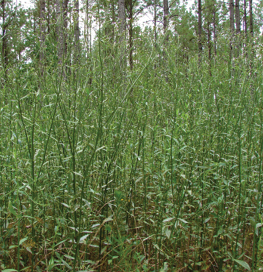
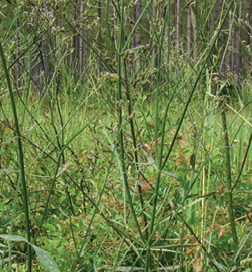
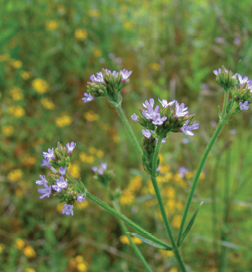
Brazilian vervain is an erect, perennial forb that grows 3 to 6 feet tall. It is tolerant of poor soil conditions, is common in old fields and along ditches and rights-of-way, grows singly or in colonies, and spreads by seeds.
- Stem: Square and somewhat rough; often branched midway or higher.
- Leaves: Opposite; elliptic to lanceolate; narrow with coarsely toothed margins; widely spaced.
- Flowers: Small, purple or lavender; April to October.
- Seeds: Tiny, oblong nutlets; July to March.
- Range: Naturalized exotic from South America; occurs throughout most of the Southeast.
- Percent crude protein: Range—11.71 to 13.8; Average 12.8.
- Deer preference: Moderate.
Common Ragweed
Ambrosia artemisiifolia
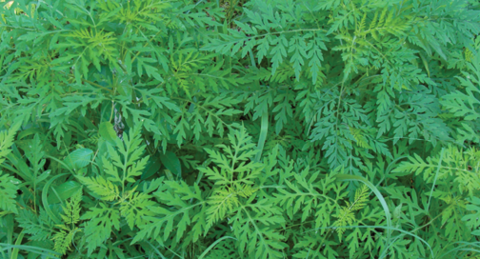
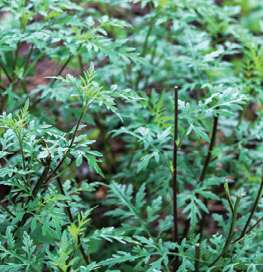
Common ragweed is an erect, warm-season annual forb that grows 3 to 6 feet tall. It grows singly or in colonies and spreads by seeds. Where seeds persist in the soil, germination often occurs after prescribed fire or soil disturbance.
- Stem: Central stem somewhat hairy with many branches.
- Leaves: Opposite near the base, becoming alternate up the stem; bipinnate and deeply lobed.
- Flowers: Yellowish-green racemes at the end tips of branches; August to November.
- Seeds: Beak-shaped nutlet; September to December.
- Range: Native to the U.S.
- Percent crude protein: Range—17.8 to 20.8; Average 19.6.
- Deer preference: High.
Beggar’s Lice or Ticktrefoil
Desmodium spp.

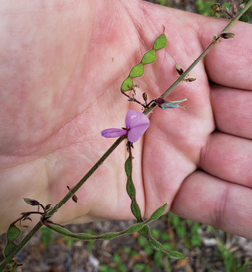

These plants are erect (some trailing), warm-season perennial forbs (legume) that range from 1.5 to 4 feet in height. Plants grow singly or in small clumps and mostly occur in open upland woods and old fields. They persist by woody root crowns, are spread by animal-dispersed seeds, and show good growth response after prescribed fire. Many species of Desmodium occur throughout the eastern United States, but not all are preferred or utilized by white-tailed deer.
- Stems: Somewhat hairy or smooth central stem depending on species.
- Leaves: Alternate with smooth margins; vary in shape and size depending on species.
- Flowers: Small pea-type with pinkish to purple petals; may occur at the junction of the stem and leaf or as erect panicles or racemes at the ends of stems depending on species; July to October.
- Seeds: A pea-like seed enclosed in small, flat pod that sticks to fur and clothing; October to December.
- Range: Native.
- Percent crude protein: Range—14.4 to 24.3; Average 19.1.
- Deer preference: Moderate to High.
Wild Lettuce
Lactuca spp.
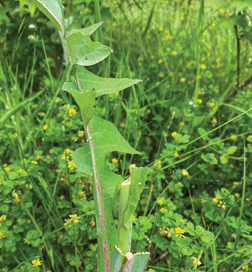
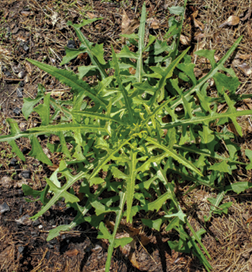

These plants are annual or biennial cool-season forbs. A flowering stem arises from a basal rosette and ranges 3 to 5 feet in height. Wild lettuce is an early invader of disturbed soils and occurs as scattered plants in open to semiopen areas but may become dense on some sites. They spread by wind and animal-dispersed seeds.
- Stem: Early growth is a basal rosette of sprouting leaves in a cluster; erect flowering stem is hollow, stout, and leafy, and may be somewhat hairy or hairless; dull, waxy green and turning red with maturity.
- Leaves: Young leaves in rosette are oblong, toothed, and may be slightly lobed; leaves along the stem are alternate and well distributed, oblanceolate to lanceolate with toothed margins and pinnately lobed; green with dull-green or creamy-white midvein.
- Flowers: Cylindrical, urn-shaped heads in spike-like or broad panicles; orange-yellow petals extend from the heads; June to November.
- Seeds: Flattened nutlet containing one bristle-plumed seed; July to December.
- Range: Native (L. serriola is a nonnative species from Europe; naturalized throughout the Southeast).
- Percent crude protein: Range—10 to 14.8; Average 13.2
- Deer preference: High
Goldenrod
Solidago spp.
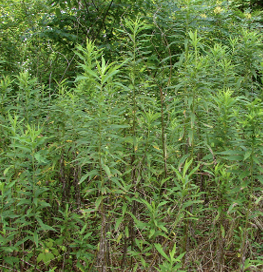

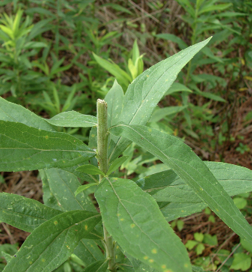
Goldenrod is an erect, warm-season perennial forb. Stems arise from basal rosettes and can grow to heights of 6 feet, depending on soil conditions and species. It spreads by seeds and rhizomes. Deer occasionally eat the basal rosettes during winter. Leaves and tender stems are eaten in spring and early summer. There are many species of goldenrods in the Southeast.
- Stem: Central stem woody-like with a pithy center; usually straight with branching near the top.
- Leaves: Young leaves in rosette oblong, with smooth or slightly toothed margins; alternate along the central stem; lanceolate or linear with smooth or toothed margins, depending on species.
- Flowers: Yellow to gold flowers in panicles at end tips of stems; July to November.
- Seeds: Tiny nutlet with white bristles; October to January.
- Range: Native.
- Percent crude protein: Range—10.6 to 19.0; Average 13.8.
- Deer preference: Moderate to High (depending on species).
Partridge Pea
Chamaecrista spp.
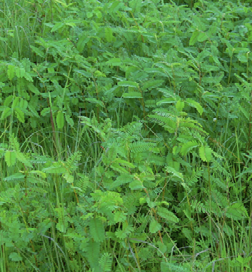
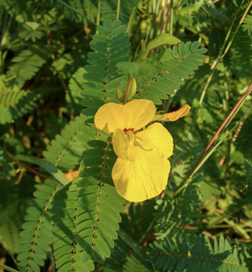
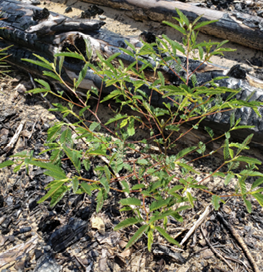
Partridge pea is an erect, warm-season annual forb (legume) that grows 1 to 2 feet tall. C. fasciculata is the larger of the two species (height, stem size, leaf size, and flower size). The plants grow in old fields, in forest openings and edges, and along roadsides. Seeds persist in the soil bank for many years, and germination often occurs after prescribed fire or soil disturbance.
- Stem: Multibranched; C. fasciculata has a greenish-brown stem that is hairy; C. nictitans has a thinner, reddish-brown stem that is smooth.
- Leaves: Alternate; pinnately compound with tiny leaflets.
- Flowers: A pea-like flower with bright-yellow petals; May to September.
- Seeds: Small pea pod containing four to 20 seeds; turns green to black when mature and dry; November to December.
- Range: Native.
- Percent crude protein: Range—15.7 to 19.2; Average 17.5.
- Deer preference: Moderate to High.
Pokeweed
Phytolacca americana
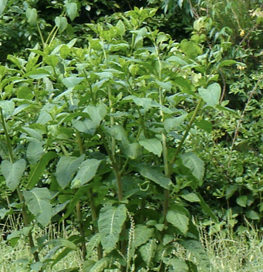
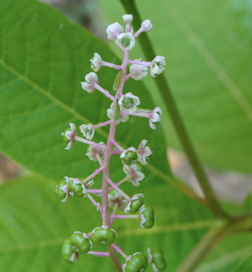

Pokeweed is an erect, warm-season annual forb that may sometimes grow to 8 feet tall. It often grows in colonies and spreads by seeds/mature fruit eaten by birds and mammals. Leaves and fruit of older plants can be mildly toxic to some animals and humans. Young leaves are highly nutritious. White-tailed deer eat both the foliage and fruit.
- Stem: Smooth with a hollow pith and many branches; turns reddish purple in late summer.
- Leaves: Alternate along the stems; elliptic to lanceolate with smooth margins.
- Flowers: White on erect to drooping racemes; May to November.
- Fruit: A round berry; green turning to deep purple when mature; August to December.
- Range: Native.
- Percent crude protein: Range—22.0 to 28.7; Average 25.9.
- Deer preference: Moderate to High.
Wild Sunflowers
Helianthus spp.


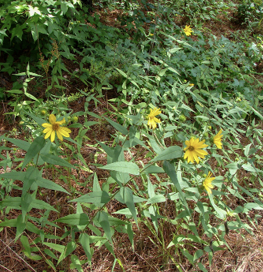
Wild sunflowers are erect perennials that arise from basal rosettes and can grow to 3 to 5 feet tall. They persist after soil disturbances and occur in new or thinned forest plantations, forest edges, and rights-of-way. Wild sunflowers are common, grow on moist and lowland sites, and spread by animal-dispersed seeds. Deer eat the flower heads and new vegetative growth in mid- to late summer.
- Stem: Grows upward from basal rosettes; stout at the base becoming slender with height and branching and wiry beneath the flowers; finely hairy to almost hairless; green to tan or reddish brown; H. divaricatus stems smooth.
- Leaves: Opposite at the base and alternately spiraling further up the stem; long linear, dark green, very rough, and hairy with whitish-green midvein underneath; entire margins; mildly aromatic when crushed. H. divaricatus leaves are opposite and narrowly lanceolate.
- Flowers: Occur in heads; yellow petals with entire margins and dark-yellow or purplish centers; July to November. H. divaricatus flowers June to August.
- Seeds: Many tiny, dull-black nutlets containing one seed; September to March.
- Range: Native
- Percent crude protein: Range—11.5 to 15.2; Average 13.0.
- Deer preference: Moderate.
Old-Field Aster
Aster spp.
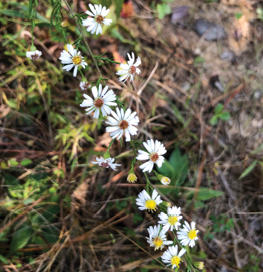


These asters are erect, warm-season perennial forbs. Stems arise from basal rosettes and can grow to about 3 feet tall in late summer. A. dumosus has a bushier appearance. These common species are early invaders of disturbed soils. They occur as scattered plants or in small colonies on moist to dry sites in old fields, forest edges, and rights-of-way. The plants spread by wind-dispersed seeds. Basal rosettes are eaten by deer in winter and early spring. Leaves and tender stems are eaten in spring and early summer.
- Stem: Grow upright from a basal rosette; semi-woody at the base with many alternate branches appearing in late summer; upper stems often hairy.
- Leaves: Alternate and becoming more numerous up the stem; elliptic- to linear-shaped and green with smooth to slightly toothed margins; upper leaves often hairy; basal leaves oblanceolate.
- Flowers: Emerge from urn-like structures and occur as heads along branches in panicles; very thin white or pinkish-white, ray-like outer petals with yellow to reddish inner petals; August to November.
- Seeds: Tiny tapered nutlet topped with whitish bristles and containing one seed; September to December.
- Range: Native.
- Percent crude protein: Range—9.1 to 17.7; Average 12.9.
- Deer preference: Moderate to High.
Sticktights
Bidens spp.
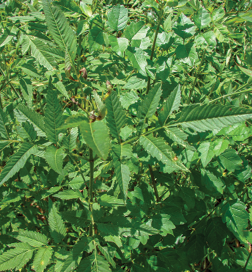
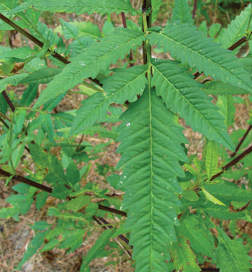

These erect, warm-season annual forbs can grow 3 to 4 feet tall. They are early invaders in areas of soil disturbance, often in sandy soils or in low-lying areas with poor drainage. The plants sometimes occur in small colonies and spread by seeds attaching to fur or clothing.
- Stem: Upright from a taproot; slender, square, and smooth and green with dark-green or maroon lines; very little foliage on spreading branches midway up the stem.
- Leaves: Opposite and compound; B. bipinnata leaves are dissected two to three times.
- Flowers: Heads occur singly at the ends of nearly leafless stems; ray-like outer flower petals are few and yellow to white in color; inner flowers around center are yellow; July to October.
- Fruit and Seed: Thin and angled nutlet containing one seed. Nutlet ½ to ¾ inch in length with three to four barbed awns at the ends; August to February.
- Range: Native.
- Percent crude protein: 18.1.
- Deer preference: B. bipinnata = High; Other species = Low to Moderate.

Woody Vines and Semi-Woody Plants
Alabama Supplejack or Rattanvine
Berchemia scandens
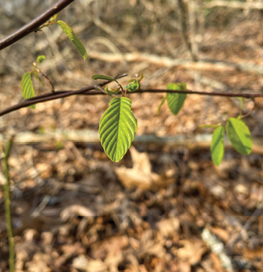
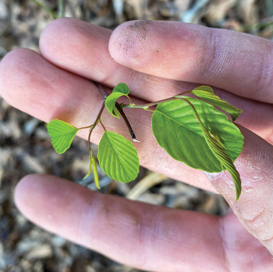

A climbing and/or trailing woody vine that persists by woody rootstock, it grows in both bottomland and upland sites. The plants persist by wood rootstocks, colonize by vine growth, and are spread by animal-dispersed seeds.
- Stem: Dull green; ranges from wiry to 3 inches in thickness.
- Leaves: Alternate; ovate to oval; shiny green above and pale green underneath.
- Flowers: Tiny and greenish white with five petals; April to May.
- Fruit: Small, berry-like drupe; blue-black and white waxy when ripe; August to November.
- Range: Native; mostly the Coastal Plain of the Southeast.
- Percent crude protein: Range—7.5 to 12.9; Average 10.2.
- Deer preference: Moderate to High.
Greenbriar
Smilax spp.
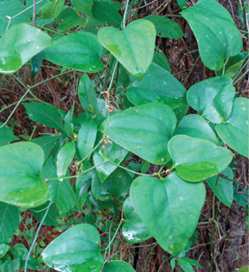
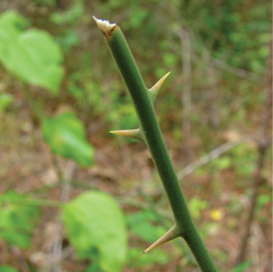
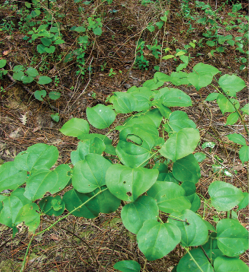
Greenbriar is a semi-woody vine, which is mostly climbing by paired tendrils. It is common and grows on a wide range of sites, moist to dry. Greenbriar persists by tuberous rhizomes and perennial vines. It spreads by bird-dispersed seeds. Many species of greenbriar occur throughout the Southeast. Most, but not all, are preferred or utilized by white-tailed deer.
- Stem: Green or mottled green; slender, round, smooth; stout thorns.
- Leaves: Alternate and semi-evergreen; shape and size vary depending on species.
- Flowers: Yellowish to brownish flowers that grow in clusters; April to June.
- Fruits: Small, round berry; green and whitish waxy ripening to shiny bluish black; September to October.
- Range: Native.
- Percent crude protein: Range—8.5 to 23.5; Average 12.8.
- Deer preference: High
Japanese Honeysuckle
Lonicera japonica
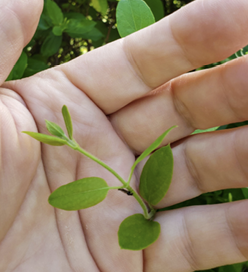
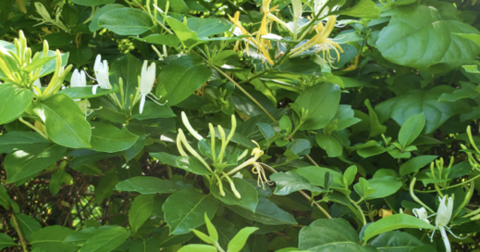
Japanese honeysuckle is a semi-evergreen, high-climbing and/or trailing woody vine that grows from long, woody rhizomes. It grows on a wide range of sites and often overwhelms and replaces native flora. Japanese honeysuckle spreads by rooting stems and animal-dispersed seeds.
- Stem: Round, slender, brown, and hairy, becoming tan barked and stout with age; branches are opposite.
- Leaves: Opposite; ovate to elliptic with fine hairs and smooth margins; often lobed in spring.
- Flowers: White and pale yellow; fragrant; April to June.
- Fruit: Round, berry-like; ripens glossy black; August to March.
- Range: Nonnative invasive species from Asia; naturalized throughout the Southeast.
- Percent crude protein: Range—8.4 to 14.2; Average 10.6.
- Deer preference: Moderate to High.
Poison Ivy
Toxicodendron radicans
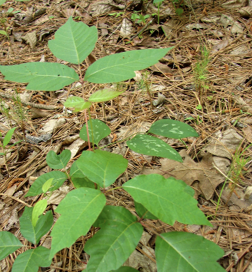
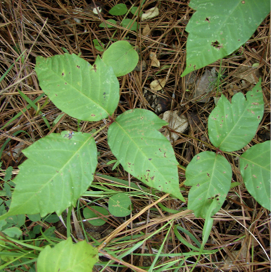

Poison ivy is a deciduous, high-climbing or trailing woody vine with erect stems. It grows on a wide range of open and shady sites, and spreads through seeds or vine runners on the ground.
- Stem: Round with rough gray to brownish bark; older stems can be 2 to 4 inches in diameter; climb by hairy aerial rootlets; branching is infrequent.
- Leaves: Alternate leaflets of three; leaflets ovate to elliptic with shallow lobes; oils in leaves and stems can be an irritant for some species.
- Flowers: Small; white to purplish; April to May.
- Fruit: Small, round, dry berry; grooved and tan; August to February.
- Range: Native.
- Percent crude protein: Range—10.3 to 12.7; Average 11.6.
- Deer preference: Low to Moderate.
Southern Dewberry
Rubus trivialis

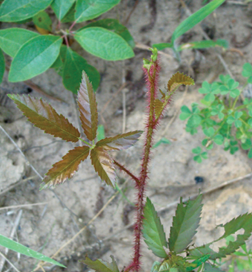
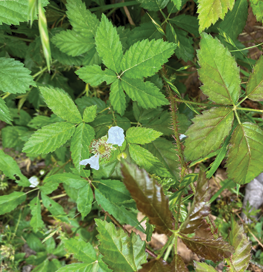
Southern dewberry is a semi-woody, trailing or low-arching plant that often grows in patches. It grows on a variety of sites, moist to dry, and in open to semi-shady habitats. Southern dewberry is a common early successional plant after timber harvest. It colonizes by rhizomes and spreads by bird- and animal-dispersed seeds.
- Stem: Vine-like with fine bristling, reddish thorns.
- Leaves: Alternate and compound, with three to five leaflets; elliptic to lanceolate shape with coarsely serrate margins.
- Flowers: White or white tinged with pink; mostly solitary but sometimes in twos or threes; March to April.
- Fruit: Cluster of small drupes called a berry; red turning to black; April to May.
- Range: Native.
- Percent crude protein: Range—10.2 to 18.0; Average 13.6.
- Deer preference: Moderate to High.
Trumpet Creeper
Campsis radicans
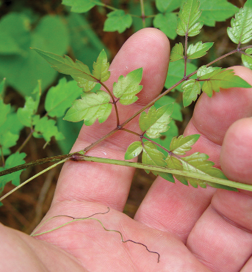
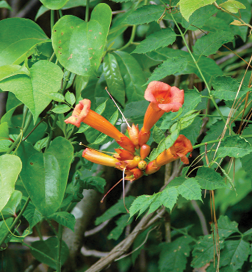
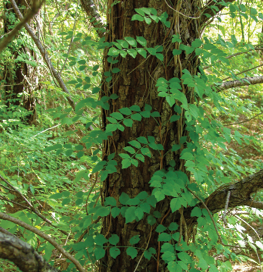
Trumpet creeper is a high-climbing and/or trailing woody vine. It grows on both open and shady sites, fence rows, old fields, and pine plantations. The plants spread by seeds and woody vine growth from root crowns.
- Stem: Older vines stout and ¼ inch to 3 inches in diameter; old growth rough and gray with new growth shiny smooth and light brown.
- Leaves: Opposite and pinnately compound; seven to 15 leaflets and coarse to finely toothed margins; shiny above and lighter green with hairy white veins underneath.
- Flowers: Reddish orange; tubular; June to October.
- Fruit: Beanlike pod with pointed ends; October to February.
- Range: Native; most frequent in the Coastal Plain and Piedmont of the Southeast.
- Percent crude protein: Range—8.4 to 27.4; Average 17.4.
- Deer preference: High.
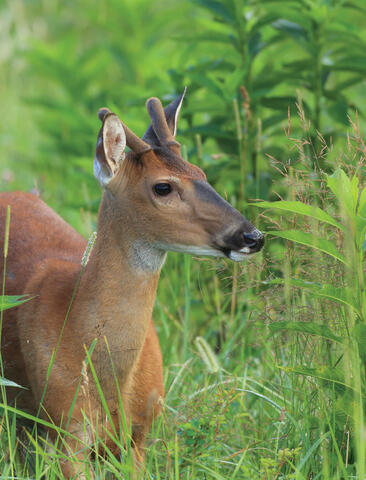
Shrubs, Briars, and Trees
American Beautyberry or French Mulberry
Callicarpa americana

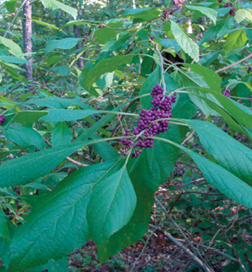
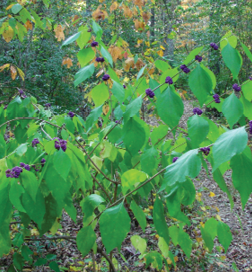
These deciduous shrubs have many branches and a bushy appearance. They grow on a variety of sites, moist to dry, and in open to shady habitats. The plants are spread by bird- and animal-dispersed seeds. Deer forage on new vegetative growth and fruits.
- Stem: Upward growing and spreading; opposite branched; young stems (new growth) light green, becoming brown to gray, with grayish-white lenticels (speckling) as they mature.
- Leaves: Opposite; ovate to lanceolate with serrate margins; hairy above and whitish and wooly underneath with prominent veins; distinct aroma when crushed.
- Flowers: Pinkish white; in clusters at the base of leaves; June to July.
- Fruit: Clusters of small, purple to violet berries.
- Range: Native.
- Percent crude protein: Range—9.7 to 17.8; Average 14.7.
- Deer preference: Moderate to High.
Blackgum
Nyssa sylvatica


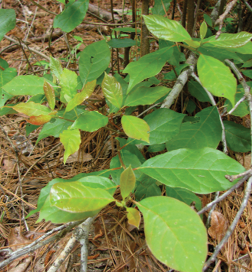
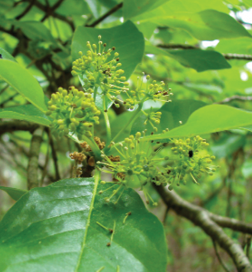
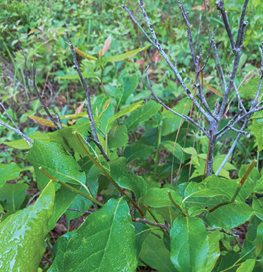
Blackgum is a medium to large tree with many slender, horizontally spreading branches. It is common throughout the Southeast and grows on moist, well-drained soils, as well as dry, upland sites among other hardwood species. Deer forage on twigs and new leaves of young trees (shrub stage) and low-growing limbs of older trees.
- Stem: Bark light to dark gray or brown and in small, rectangular plates on young trees. Twigs slender, grayish brown, with many grayish-white lenticels (speckling).
- Leaves: Simple and alternate; deciduous; elliptic to oblong; green and glossy with entire margins; on sprouts or young trees, leaves may have a few coarse teeth; leaves turn scarlet red in the fall.
- Flowers: Tiny greenish yellow in clusters at ends of new twig growth; April to June.
- Fruit: Egg-shaped, small drupe about ½ inch long turning bluish black when ripe; August to October.
- Range: Native.
- Percent crude protein: 9.1 to 13.88; Average 11.8.
- Deer preference: Moderate to High.
Huckleberry or Wild Blueberry
Vaccinium spp.
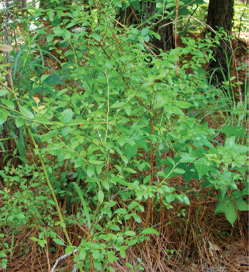
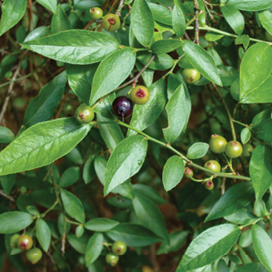
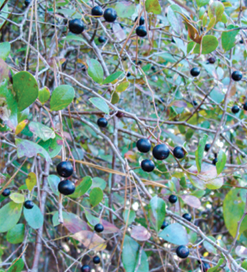
Huckleberry is an erect, branching, and “bushy” shrub that often grows in small patches but not from rhizomes. It occurs in upland and bottomland open forests. Seeds are dispersed by birds and other animals.
- Stem: Upward-growing, round stems; branching with slender twigs; grayish-brown bark on trunk shredding in thin plates; new growth of stems smooth and green.
- Leaves: Alternate; semi-evergreen; elliptic to oval with finely serrate margins; shiny above and light green underneath.
- Flowers: White to pinkish and vase-shaped in clusters of three to five; March to April.
- Fruit: Small, round berries; green ripening to dark blue; sweet and juicy when ripe; May to June.
- Range: Native.
- Percent crude protein: Range—5.8 to 20.6; Average 10.3.
- Deer preference: Moderate to High.
Blackberry
Rubus argutus


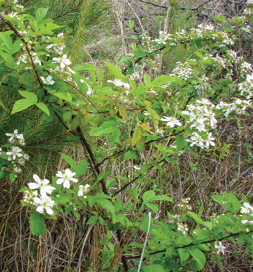
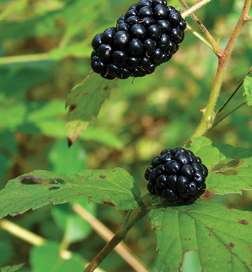
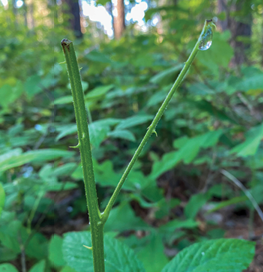
Blackberry is an erect or arching, semi-woody, shrub-like plant that grows singly or in dense colonies. It grows on a variety of sites, moist to dry, and on open to semi-shady habitats. Blackberry is a common early successional plant after timber harvest. It colonizes by rhizomes and spreads by bird- and animal-dispersed seeds. Deer forage on new vegetative growth and fruits.
- Stem: Mottled green with grooved ridges and armed with flat, hooked thorns; alternate branching on the upper part of main stem.
- Leaves: Alternate and compound with three to five leaflets; leaflets elliptic to lanceolate with serrate margins and whitish green underneath.
- Flowers: White to pink with five petals; April to July.
- Fruit: Cluster of small drupelets called berries; turning red to black; April to August.
- Range: Native.
- Percent crude protein: Range—8.7 to 14.1; Average 11.3.
- Deer preference: Moderate.


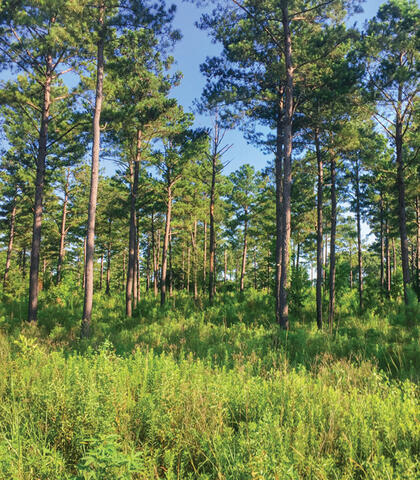
Conclusion
Species cited in this publication are by no means a comprehensive list of native deer forages. They are simply a list of common, naturally occurring plants deer use in Mississippi and throughout the Southeast. Learning these plants and how to identify them will provide you with a starting point to monitor deer use and relative browsing pressure, which serve as indicators of habitat conditions and population status on your property or hunting lease.
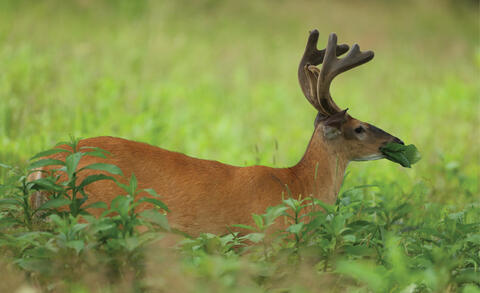
Sources of Plant Information
Harper, C. A. 2019. Wildlife Food Plots and Early Successional Plants. NOSCO.
Miller, J. H., and K. V. Miller. 2005. Forest Plants of the Southeast and Their Wildlife Uses. The University of Georgia Press.
Warren, R. C., and G. A. Hurst. 1981. Ratings of Plants in Pine Plantations as White-Tailed Deer Food. Mississippi Agricultural and Forestry Experiment Station Information Bulletin 18.
Sources for Percent Crude Protein Values
Mixon, M. R., S. Demarais, P. D. Jones, and B. J. Rude. 2009. Deer forage response to herbicide and fire in mid-rotation CRP pine plantations. Journal of Wildlife Management 73:663-668.
Jones, P. D., S. Demarais, B. K. Strickland, and S. L. Edwards. 2008. Soil region effects on white-tailed deer forage protein content. Southeastern Naturalist 7:595-606.
Iglay, R. B., P. D. Jones, S. Demarais, D. A. Miller, B. D. Leopold, and L. W. Burger, Jr. 2010. Deer carrying capacity in mid-rotation pine plantations in Mississippi. Journal of Wildlife Management 74:1003-1012.
Jones, P. D., S. L. Edwards, and S. Demarais. 2009. White-tailed deer foraging habitat in intensively established loblolly pine plantations. Journal of Wildlife Management 73:488-496.
Jones, P. D., B. K. Strickland, S. Demarais, B. J. Rude, J. P. Muir, and S. L. Edwards. 2010. Soils and forage quality as predictors of white-tailed deer morphometrics. Wildlife Biology 16:430-439.
Nichols, R. 2020. Effects of fire phenology and stump sprouting on summer nutritional carrying capacity for white-tailed deer. Thesis, Mississippi State University.
Some additional values were collected by Phil Jones, Mississippi State University, and Craig Harper, University of Tennessee.
Thank you to the following reviewers of this publication:
John Gruchy, Private Lands Program Coordinator, Mississippi Department of Wildlife, Fisheries, and Parks
Rainer Nichols, AWB® MSARNG Prescribed Fire Program Manager
P3618 (POD-02-24)
By Bill Hamrick, Senior Extension Associate; Bronson Strickland, PhD, Extension Professor; and Steve Demarais, PhD, Professor and Taylor Endowed Chair, Department of Wildlife, Fisheries, and Aquaculture.
The Mississippi State University Extension Service is working to ensure all web content is accessible to all users. If you need assistance accessing any of our content, please email the webteam or call 662-325-2262.
